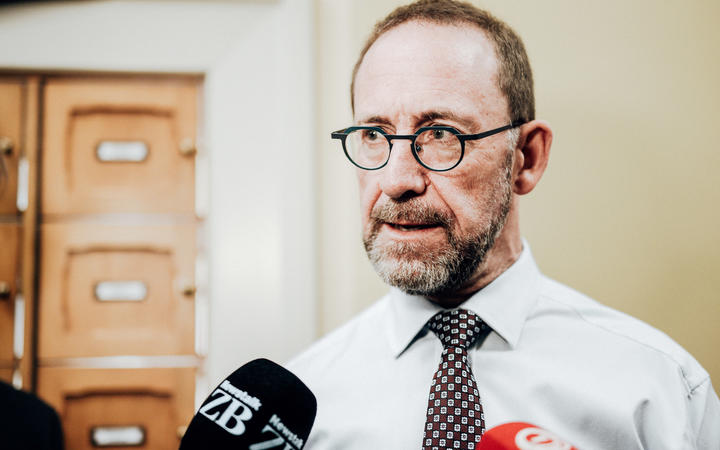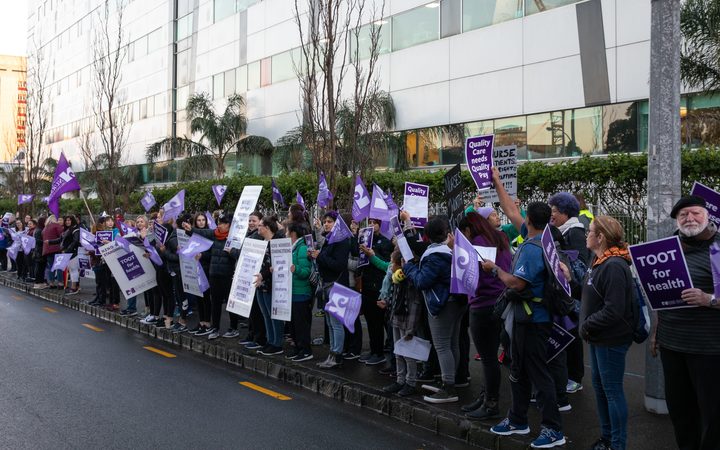The Opposition says health money should be spent on essential staff like nurses rather than on expensive back-office restructures.
 National Party health spokesperson Shane Reti. Photo: RNZ / Dom Thomas
National Party health spokesperson Shane Reti. Photo: RNZ / Dom Thomas
About 30,000 nurses will strike for eight hours tomorrow, after rejecting a second offer from the district health boards.
When the government announced in May that wages in the public sector would be restricted for three years, the Nurses Organisation warned that the decision might push its members to vote for strike action.
National Party health spokesperson Shane Reti told Morning Reporthe could not understand why the government would set aside $486 million to restructure the health system, but keep pay restrictions for public servants.
“To land them with a pay freeze, I’m afraid, is unacceptable and just terribly disappointing,” he said.
“I think in that context what’s hard to explain is why the Budget would announce $486 million in health restructuring layers and layers of bureaucracy and you’re putting a pay freeze on doctors and nurses who are delivering the coronavirus vaccine.”
He said people would likely go to Australia because of the pay freeze.
“We should have huge concerns that this will drive our health workforce offshore.”
He said it was disappointing nurses, who worked on the frontline during the pandemic, were having to strike for better pay and staffing. However, he could not say how much the party would be able offer nurses if they were in power.
“We don’t know what’s under the hood [with Treasury figures], so we can’t commit to numbers. But what I can tell you is if I had a choice of $486 million and thousands of bureaucrats in a health restructuring or removing the pay freeze and valuing nurses, I’m darned sure I know what I’d do and I think it’s probably what New Zealanders would do as well.”
Health Minister Andrew Little told Morning Report the money for the system overhaul was adhering to an agreement in a previous pay settlement around critical care management, which is about increasing nurses in hospitals.

Health Minister Andrew Little. Photo: Dom Thomas
“Ten DHBs say they’ll largely be there by the end of this month, another seven possibly by the end of the year, three more, who knows when, sometime next year.
“Because we have this disaggregated system of health administration, we can’t get any consistency across our hospitals … the reason we need those reforms is to get more consistent decision-making, better standards and a better working life for those working in the system.”
Little said he sympathised with nurses and acknowledged their efforts amid the pandemic and ongoing staffing issues.
“Nurses at the frontline are really under the pump, are really under the pressure and they quite rightly called out to be fairly rewarded and pay levels that reflect the skills and responsibilities that they carry.
“As minister, I’m concerned that there is a critically important workforce that feels they do and feels they only way they can get their voice heard is to take industrial action. That’s not a criticism of them, it’s a respect for the judgement they’ve collectively made.
“I can consider it my responsibility as minister to make sure I’m doing … everything we can to meet the concerns they have.”
‘They think they’re worth more than that’
 Nurses took to the streets of Auckland in 2018 as well, after failed negotiations back then. Photo: RNZ / Dan Cook
Nurses took to the streets of Auckland in 2018 as well, after failed negotiations back then. Photo: RNZ / Dan CookNew Zealand Nurses Organisation (NZNO) industrial services manager Glenda Alexander told Morning Report the revised pay offer was not good enough, with members not having had a pay increase for two years.
“They think they’re worth more than that.”
She said nurses earned anywhere from $54,000 up to $80,000, but did not consider that to be a lot when taking into account their skills knowledge and responsibilities.
The revised offer from the DHBs offered a down payment of $4000 to all staff, ahead of their pay equity claim to be settled later on this year.
“That lump sum payment effectively gets taxed and doesn’t go on their pay rates, so it doesn’t really lift the pay rates in an ongoing way, so it’s really a part payment of something that potentially they’re already owed,” Alexander said.
Minister of Health Andrew Little said the offer reflected the pay restraint principles the government had determined, and gave those at the lower end a higher percentage increase than those at the top end.
“But it is within the pay restraint and against the background of the still incomplete pay equity deal that is still to be finalised and worked out.
“That’s likely to be concluded later this year or early next year, but that will have an impact as as well.
“There’s the pay levels that are represented in the collective agreement so the dollar rate increases on those pay bands and levels, that’s one thing.
“Then there is the pay equity process … [which] will ultimately lead to structural increases for nurses and midwives.
“There was an expectation it would be largely complete by now, it’s not, it’s way more complex, but it does have a start point, December 2019. So as time goes on from now, there’s going to be pay owing to nurses and midwives and healthcare assistants.”
Asked why the two parts where condensed into one, he said: “In the end, it’s about getting cash in people’s hands … and we know the outcome of negotiated pay increases as well as the outcome of the pay equity deal, when it is concluded, is that there are structural increases in people’s pay rates.”
Alexander also wanted to see the DHBs address under-staffing alongside the pay issues.
“The irony being that they’re actually requesting more nurses be present on the strike day than what are usually there due to short staffing.
“It is what happens on a daily basis, there’s simply not enough staff to do the work safely and that’s what our issue has been throughout this dispute.
“There are places where it’s worse and places where it’s slightly better but overall it’s the same, there are just not enough people to do the work that’s required.
“People are exhausted, they’re worried about making mistakes and errors.”
Little said he would need to investigate any claim that would suggest that cover provided for these instances was greater than normal days.
